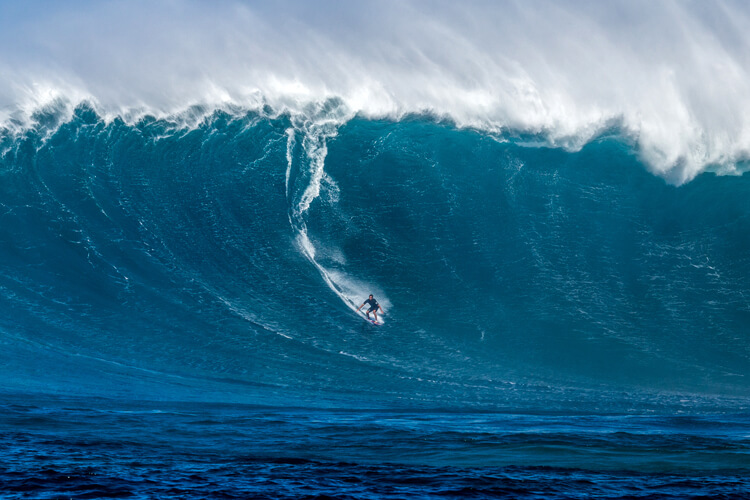Sooner or later, the ambition of most surfers leads them to think of the big surf.
The fact that there are probably no more than 50 people alive who consistently ride the biggest waves and that these people are usually lifeguards or champion swimmers is no deterrent.
The big surf is the secret aim of practically every surfer from the moment he first stands up at Waikiki or Huntington Beach, although perhaps he would be more cautious if he knew some of the facts.
There is surf of some kind or other on every seashore in the world.
The surf varies greatly from the almost continual surf of Peru, which is a result of the constant storms of the "Roaring Forties," to the rough, intermittent, and local surf of the western European coastline.
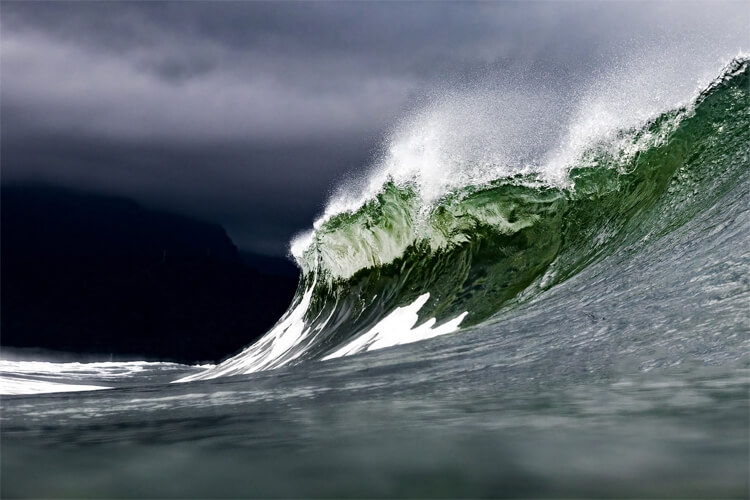
The Formation of Waves
To understand the surf and how it is formed should be the aims of every prudent surfer.
Before he goes out on any of the northern Oahuan beaches, an experienced surfer will sit for half an hour or more watching the wave patterns as they thunder across the bay and observing the currents and rips as they return the water from the broken waves to the ocean.
He will assess whether the surf is rising or falling, coming up or going down, and thus what the chances are of feared close-out waves which break across the entire front.
Lastly, he will note his escape routes should he get trapped by a large set of waves so that he can decide the risks of going out at all.
Most waves are caused by the wind blowing over the sea, starting as mere ripples on the surface and increasing rapidly in size as the wind increases in force.
In gales of several days, waves can continue to build up, except for nature's way of keeping the equilibrium.
After the wave has grown so high that the height from crest to trough is seven times the distance from one crest to the next, it spills over into a white cap or breaker.
A wind of over 40 miles per hour will blow the tops off the waves, anyway, so that the highest waves may occur when the gale subsides.
Every 10 miles per hour of wind is said to increase the waves five feet in height, although waves will average 70 feet high or better in winds of hurricane force.
The speed of the waves is often only a little less than the wind from which it sprang.
In case this is misconstrued, it must be pointed out that the wave at sea is not a moving wall of water, nor is the water in the wave merely moving up and down.
In actuality, each drop of water is traveling at less than one foot per second, in a circular or ellipsoidal path ending up in the same place in which it started.
Eventually, the waves outrun the storm, which produces them.
They then become a swell which is gradually reduced in height while the crests lapse into a wider interval; they may become so low that as they mix with other swells and currents, they will go unnoticed; although the lower limiting speed of these waves is still about 15 m.p.h., which should answer the question "How fast is the surf?"
Ground swells often travel for thousands of miles until they finally approach a coastline.
As a reef or shoal shortens the oscillation of the revolving water, the waves build up in height and come tumbling down with a tremendous roar as the pressure of other waves piling up behind them causes them to break.
It is waves like these which make the north side of Oahu one of the world's finest surfing coasts.
Of course, it is not that simple, and local effects can be caused by currents, tides, and nearby storms, which change the whole pattern of the break.
Local storms are easy to detect since the accompanying waves are sharp and pointed, and white caps can be seen far out to sea, as when the Kona wind is blowing at Makaha.
Currents and rip tides, if strong enough, may divert the swell completely.
It is often dangerous to swim on any surfless beaches of a coast which receives an almost uniform surf.
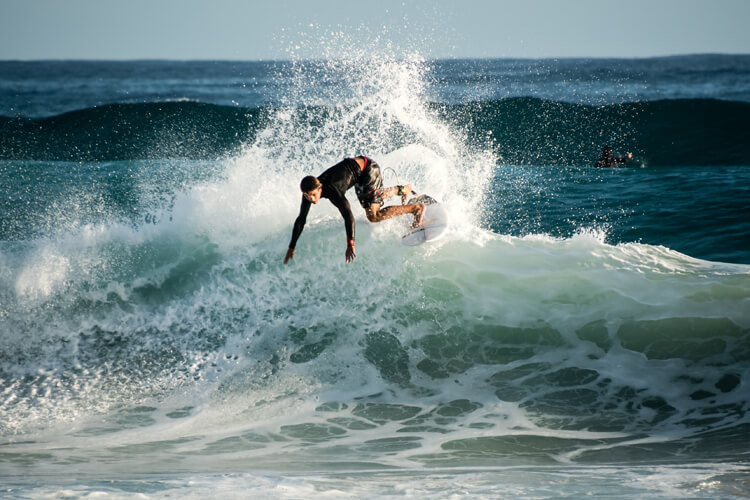
Types of Surf Breaks
The type of ocean floor determines the regularity of the surf.
The most predictable beaches have either a rocky bottom, often confined by the presence of cliffs, or a coral reef which changes its shape very slowly.
Sand beaches are the least consistent; their surf may be changing constantly.
In the summer, the lighter, thinner waves may build up these beaches at the rate of several feet a day as the grains of sand are lifted from the bottom to be deposited by the waves in a new place.
The heavy surf in winter holds the sand up much longer, and tearing down the beaches eventually deposits them as sand bars farther out to sea, and so the cycle repeats itself year after year.
Headlands, rock outcrops, or coral peaks are other features which will change the entire wave formation, and together with irregularities in the ocean flow, can force the waves suddenly to change direction and even to approach the beaches at a slant.
Southern or northern swells will swing completely around and face the other way due to the friction of nearby landforms, as they do on many Pacific beaches.
Waikiki gets all its winter surf in this way.
Contrary to widely held beliefs among surfers, there are many places in the world which have surf of outstanding dimensions.
On many coastlines which face the open ocean, when the waves approach the shore, their destructive power increases until its force is almost impossible to measure.
A passage from the British Island Pilot, originally quoted by Rachel Carson, graphically describes this power.
"...upon the open coast, the sea rises at once, and striking upon the rocky shores rises in foam for several hundred feet and spreads over the whole country."
"The sea, however, is not so heavy in the violent gales of a short continuance as when an ordinary gale has been blowing for many days; the whole force of the Atlantic is then beating against the shores of the Orkneys, rocks of many tons in weight are lifted from their beds, and the roar of the surge may be heard for twenty miles; the breakers rise to the height of 60 feet..."
In 1872 at Wick, Scotland, a concrete breakwater and its underlying bedrock weighing 2,700 pounds, or 1,350 tons, were torn loose and smashed against the shore.
Five years later, a new pier weighing twice as much was destroyed by the tremendous surf.
The largest wave actually measured at sea was 112 feet, recorded by the U.S.S. Ramapo on a journey from Manila to San Diego.
Yet the windows of the lighthouse at Dunnet Head, Scotland, have been repeatedly broken by rocks thrown 30o feet into the air by the surf.
(There's no rush, gremlins; the next boat doesn't leave till Friday!)
Miss Carson further reports at the Trinidad Head Light, Northern California, which is 196 feet above high tide, a wave rose in what appeared to be a solid wall of water and engulfed the tower in spray.
So strong was the impact that the light stopped revolving. Many of these shore breaks are much larger than tidal waves.
The latter, which are now known by their scientific name "tsunamis," are caused by earthquakes in the Aleutians, Japan, Chile, and other similar places.
The waves in the open sea may be only a few inches high with many miles between each succeeding crest, but the speed of the wave could be 500 miles per hour.
When the tidal wave hits a coastline, nothing occurs at first until the sea starts to withdraw and quickly shows the sandy bottom or the reef, as if the tide had just gone out.
This may be for several hundred yards until the suction forces a much larger wave 25 or 50 feet or more in height to sweep in over the shore, as it did in Hilo Bay, Hawaii, in the spring of 1960.
These waves do not come in like surf (although some surfers have tried to ride them) but more like a tide which is rising fast.
As the water finally withdraws with a great deal of noise, it may take houses, people, and automobiles way out to sea with it.
There is now a warning system to protect the Hawaiian Islands from "tsunamis."
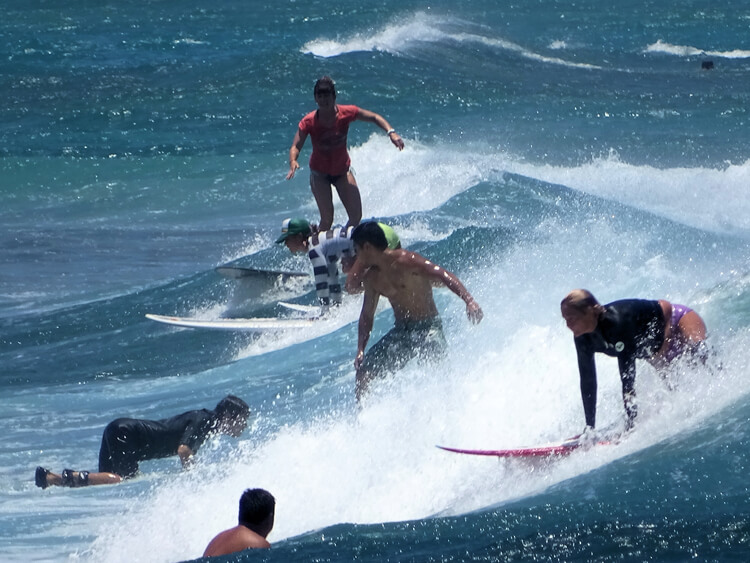
Rips and Currents
The best waves for surfing are developed where the ocean bottom is relatively flat so that the wave will take a long time to build into a breaker.
On a good day, Waikiki is therefore ideal because of its extensive coral formations.
Where the bottom is steep, sandbanks are built up by the waves, and a heavy line of breakers forms along this bank.
This usually means a short and often dangerous ride.
As we have already seen, the wave which bears the surfer is moving itself, but the water is almost stationary.
If this were not so, he would not be able to coast over swells while waiting for the next wave to ride.
After the wave has broken, however, the entire surface mass of water is set into motion for some distance at least, which is why you are usually carried shoreward by the soup.
On many surfing beaches, the soup runs into the shore at considerable speed, and when the surf is running high, strong rip tides may develop to take the water out to sea again.
These start as cross currents near the beach which join to form a V-shaped area of sea which is free from surf.
Underneath this, deep channels may be cut by the action of the current.
The rip usually runs out after it has passed the last line of breakers and diffuses into the mass of ocean water, but strong rips sometimes travel miles before they lose their impetus.
When heavy surf is running, the rips may reach a speed of several miles per hour.
If you are caught in one, there is nothing to do but swim, float, or paddle with it, carefully conserving your strength until its force has dissipated, and then swim or paddle across to the line of breakers and come in with them.
As usual, panic is your most dangerous enemy at this point.
It is useless to try and fight a riptide; you will merely tire yourself out for the long swim into shore and will probably impair your chances of making it.
All the surfing beaches on Northern Oahu, such as Pupukea, Sunset, and Waimea Bay, have rips of some kind.
With the possible exception of Pupukea, these are dangerous, so that when surfing any of these beaches, you should be careful of any area where the wave line is not continuous.
Although experienced surfers sometimes use rips for a free ride "outside," most people are advised to stay out of them.
According to George Downing, all the rips on Northern Oahu run counter-clockwise.
The rip at Pupukea is fortunately small and brings you back along the shore after first taking you towards Sunset Beach.
But the rip at Sunset itself runs in a great circle skirting the entire bay.
Near the center of the beach, the current changes direction, providing a gap in the rip which enables surfers to reach the shore.
Waimea Bay has a very strong rip, like most short, crescent-shaped beaches, and in heavy surf, you can be swept far out to sea by the strong currents which also run outside the surf.
Sometimes the only way back is a swim to Haleiwa three or four miles away, a most unpleasant prospect in rough seas.
Waikiki is the safest beach on the Islands, and except on the rare occasions when a heavy surf is running, there are no rips or currents to worry about.
Water will also return from beaches in the form of undertows, the suction of which can be felt by any surfer who has dived under an approaching wave.
This undertow is not normally dangerous unless, in periods of unusually strong suction, it breaks up the edge of a sandbank and pulls a general exodus of water out to sea.
John Bloomfield reports that 200 surfers were swept out to sea in this way at Bondi Beach, Sydney, in 1938.
In spite of the outstanding efforts of the great Bondi life-saving clubs, five surfbathers lost their lives in surfing's worst accident ever.
Waikiki has big waves for only a few days every year, but on one or other of the Oahu beaches, some good-sized waves are usually available almost continuously from October to March.
Many surfers feel that Makaha and Yokahama Bay are easier than Pupukea or Haleiwa, but the surf is much less reliable at the former beaches because of their location.
This faces southwest like Waikiki but depends on northern swells swinging 180 degrees around Kaena Point for their best surf.
Fortunately, by telephoning Kaiser's KHVH TV station during the week, you can always find out the condition of the surf at Makaha as well as at Waikiki and Makapuu.
It is to be hoped that this excellent information service will be extended in time to Waimea Bay and Sunset Beach.
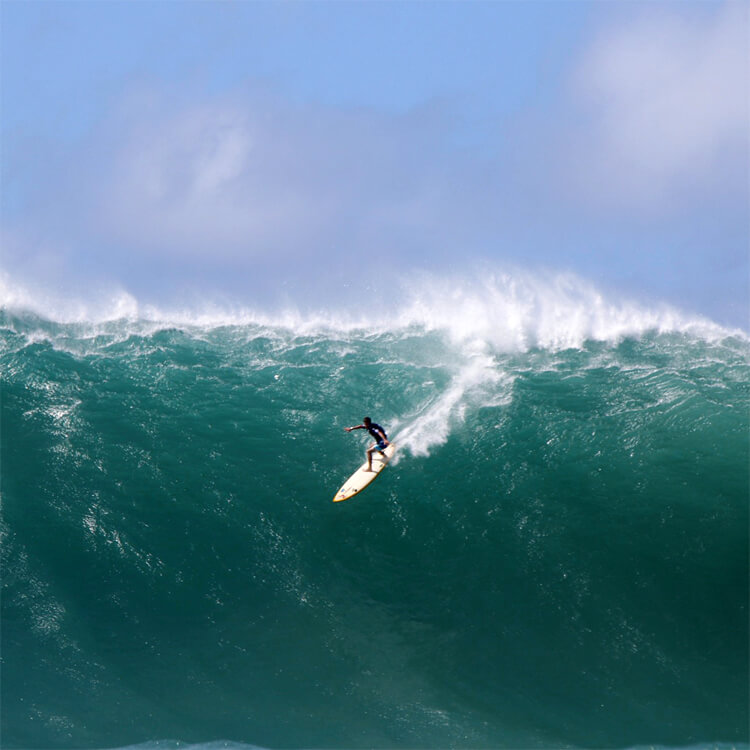
Hawaiian Big Wave Arenas
The Makaha Bay is about 40 miles northwest of Honolulu and is at the base of the Waianae Range.
The country is dry and not unlike parts of the California coast.
The advantage of this beach lies in its less dangerous rips and currents which makes surfing on many days reasonably safe for beginners.
There are frequently three, four, and five-foot days at Makaha when most people can enjoy themselves and become familiar with the beach.
The surf can come up fast, however, and when it does, the beach is much less safe.
The big surf is usually further out to sea, a rough rule being that a 20-foot wave needs a 27-foot depth of water, a 30-foot wave needs a 40-foot depth, and so on.
Although some people discount this rule, most big waves break in water which is at least 20-30 feet deep.
Waves have been known to reach 40 feet and more at Makaha. Some say they have also been surfed at this height.
Many surfers will tell you that Makaha has the best big wave on the Islands, a long, glassy wall which gives you as lengthy a ride as you can get on a good-sized wave off Oahu.
In January 1959, there were 42 continuous hours of 20-foot surf in the bay at Makaha and its environs.
Fortunately, if you are waiting for a big one, you can usually judge the size by seeing how high the wave is going around the point.
If it is 6 feet there, it will probably be 20 feet where you are waiting.
James Blears, Pat Curran, and some other surfers were out at Makaha sitting on their boards one day when Pat suddenly stood up, looked out to sea, and without another word dove straight to the bottom.
The others naturally followed suit as rapidly as they could.
About 30 seconds later, they felt the terrifying turbulence of a huge wave (30 feet) breaking above them. Luckily they were out of reach.
The general rule is that turbulence will affect the water to about half the distance of the height of the wave, which would be 15 feet for a 30-foot wave like this.
This story does give you some idea of the speed of the build-up of waves at Makaha.
When the surf is up, there are also strong crosscurrents in the bay, and inexperienced swimmers can easily get into distress, although all currents are less severe at Makaha than those of the northern surfing spots.
A further welcome difference is the relatively clear water which enables you to see light after a wipeout.
On the other side of Oahu, a surfer is usually blind when under the surface, which is not so good - but at Makaha, you can see the soup rolling over you in great clouds of turbulent water.
About two miles past Makaha, there is the really excellent surfing beach called Yokahama Bay which offers a short ride close to the shore without dangerous currents.
The build-up is quick with a good take-off. The waves are very steep, giving the surfer a fast, wild, exciting ride which few forget.
When Makaha surf is up, Yokahama is usually good as well.
The location of Waimea Bay has already been described in the previous chapter.
It is a small bay surrounded by low rocky cliffs, opening up into a wide Hawaiian valley with a waterfall in the rear.
The water for more than go percent of the year is almost as flat as a millpond, and as Larry says, when the surf's not running, it does not look like much.
The build-up at Waimea is very rapid; a wave which is only 8 to 10 feet when it hits the reef may rise to 25 feet in a few seconds.
The surf also comes up very fast, and when it does, the shore break is enormous.
Occasionally a big wave will "close out" the bay, and surfers caught in the crush will be lucky to escape with their lives.
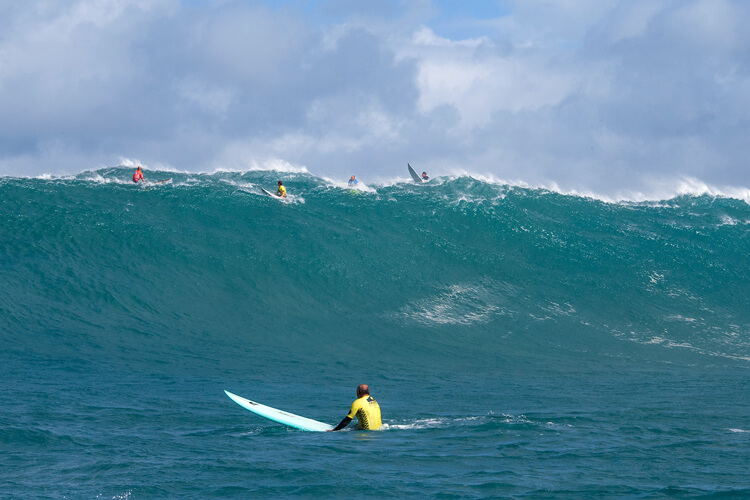
Waimea Bay: A Tricky Surf Break
Waimea rips are also dangerous for swimmers.
In December 1958, after a bad wipeout, a California surfer, called Jim Caldwell, was swept far out to sea behind the line of breakers.
Ricky Gregg, who had gone out to help him, suffered a similar fate.
Unable to negotiate either the currents or the heavy surf, they were eventually rescued hours later by local firemen with an Air-Sea Rescue helicopter standing by.
Obviously, Waimea Bay is hardly a spot for the beginning surfer.
It is regularly ridden annually by a hardy bunch of expatriate Californians led by Peter Cole, and including Pat Curran, Mike Diffenderfer, Paul Gebauer, Byron Keough, and several others.
I will quote Peter Cole in an attempt to catch some of the high-pitched excitement of a big wave surfing session.
"The biggest day of the year at Waimea was January 10, similar to the biggest day of the year before, except the bay did not close out, and there were no near drownings."
"The morning started with the surf just barely big enough to ride, and then by later afternoon, waves 25 feet and higher were hitting, with more water in them and more size than I have seen since I've surfed."
"The surfers that day included Pat Curran, Mike Diffenderfer, Jack Webb, Byron Keough, and Paul Gebauer, plus two who tried the biggest stuff for one of the first times - Fred Van Dyke from Santa Cruz (now a Hawaii school teacher) and L. J. Richards of Oceanside, as fine a surfer as you'll find anywhere."
"This was the big day, and everyone could sense it, and the air was filled with excitement. The lines were more definite than at any time during the year, and Makaha was reporting its only point surf of the year."
"The surf was inconsistent, with only one or two waves per set, but each was at least io feet in size. Diffenderfer took off on the first big one and dropped straight to the bottom."
"Then Gebauer, who rode more waves than anyone that day because of an almost inhuman aggressiveness, took off way inside on a zo-foot-plus wave, and Van Dyke on his outside rode extremely high and made the wave as Paul "souped out" at the bottom."
"Curren was the next rider, planing the monster perfectly, making it after doing everything right. Webb took off on the same wave closer to the point than anyone I've ever seen and took a terrible wipeout immediately after reaching the bottom of the wave. Pat came back screaming of the size."
"The next big one, supposedly the wave of the day and of the year, was one in which I took off on the inside, Pat on my side and Byron on Pat's outside. The wave seemed large, but Waimea never seems as large to the rider as it does to the spec-tators on film."
"On the wave, Byron's edge caught, and he fell over both Pat and me. The last I remember was seeing Pat ahead of me on the way out of a gigantic curl while I was completely inside of the curl, knowing that I didn't have a chance."
"Amazingly, Pat made the wave for probably the best ride ever attained at Waimea Bay. The wave in pictures measures 25-28 feet and has become a much-talked-about wave. Byron's board came out with a crack down the middle. I was not aware of the power of the soup, as I got air right after the impact of the soup, which saved me from having a bad wipeout."
Waimea Bay is spectacular because it is close to the shore, but there are numerous other beaches which have big waves on the north side of Oahu.
As you drive along the peripheral highway, which skirts the coastline, you can see good-sized breakers from time to time in many places.
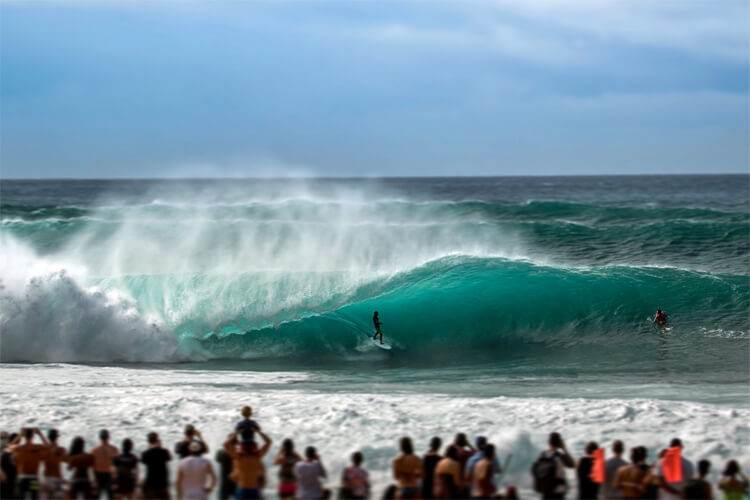
Banzai Pipeline and Sunset Beach
New spots are constantly being discovered, or old ones tried again, such as the notorious and dangerous Banzai Pipeline near Haleiwa, but the old places continue to gain in Livor and are not likely to lose their popularity.
And so we return again to Sunset Beach, probably the most difficult and treacherous surfing location on the islands when a big surf is running.
The waves at Sunset are enormous in bulk as well as height, a fact which is not too obvious from the shore. You have to paddle out to see them.
The width and the great mass of the waves is over-awing, at least three times that at Waikiki.
Even small ones look large; you feel a huge swell beneath you like an enormous whale-backed ani-mal stirring in the depths.
And worst of all, they don't come from a predictable direction.
If they're breaking and you try to get out of their way, they seem to follow you, determined to get you, maneuvering like lines of marines on a barrack square.
If you wipe out at Sunset, I'm told, there is a terrible feeling that something is pulling you under, and the soup is so violent that if you try and get out of it, you may find yourself swimming downward instead of up.
Some of the surf is almost impossible to swim through.
Strong swimmers can get underneath it and come up in the lulls, but in that kind of turbulence, it's easy to get a mouthful of salt water; your will to continue decreases, abetted by that horrible sinking feeling as you watch your board getting swept further toward the shore with each successive wave.
Fortunately, if you keep out of the rips and if you float in the general direction of the shore, sooner or later, you are liable to get washed up on the beach, conscious or otherwise.
On a big day at Sunset, when the waves are 30 feet or so, there may be a crowd of l000 or more people watching the unregistered suicides trying their luck, while the air is filled with spray and the sea is roaring like an angry animal.
This is strictly one at a time surfing, and some of the wipeouts (which is what the crowd in gladiatorial fashion is waiting for) are terrifying.
Surfers have been known to be trapped in the curl as the wave broke and to be whirled around for one and a half revolutions in a wave which broke twice.
John Severson tells the frightening story of the two surfers, David Cross and Woody Brown, who started out on an eight-foot day and just kept paddling.
The surf had started to come up and showed no sign of stopping.
By paddling like mad, they teetered over set after set, the waves of which were getting increasingly large, finally deciding after about a mile of this to try to reach Waimea Bay.
David Cross was picked off by an outside break and sucked under. Woody Brown was washed up on the beach unconscious.
Big Wave Surfing Tips
These are some points confirmed by expert big wave surfers.
1. Only first-rate swimmers (remember Duke Kahanamoku?) should ride big waves. Practice your swimming every day.
(There are very rare exceptions to this rule. Henry Lum, the Chinese-Hawaiian surfer, rides 20-foot waves at Makaha, and by floating and dog-paddling - he cannot swim - he somehow manages to survive any wipeouts.)
2. Big wave surfers should go into training.
3. You should use a big wave board made by a specialist. These boards are known as elephant guns, under the theory that you do not use a .22 for shooting elephants.
The La Jolla group headed by Pat Curran uses a 10 foot, 6 inch, 30-40 pound stream-lined pintail with the widest point 1/3 back from the nose.
The board is made of balsa with 5 to 12 redwood strips.
The final result is most handsome, gleaming, and shining like the side of a yacht. Many big-wave surfers use heavier boards than this - some use different boards for different beaches.
4. Master Waikiki, Makaha, and Pupukea before you try Sunset or Waimea Bay.
5. Try Sunset first with an experienced big wave friend on a quiet day when there are no others around.
An experienced surfer who is a lifeguard is the best companion in these circumstances.
Weekday mornings are usually good. January-March are the least crowded months.
6. After arriving at the place where the big waves are forming, wait for a while before you go out.
Note the conditions of the surf, whether it is coming up or going down; note the chances of close-outs which occur at the peak and are the result of an exceptional storm. Confidence in surfing comes from knowing your beach, tides, and currents backward.
7. Try to keep relaxed. (What a hope!)
Always paddle round the surf to avoid other surfers and breaking waves. Avoid drift.
Fix your position by sighting lines on two distant objects themselves in line.
8. Always take a deep breath before you catch the wave or before you wipe out. Practice holding your breath.
Half a minute of being pounded about in boiling soup after the vigorous exercise of paddling may seem like three minutes on dry land.
Wipeouts in big waves average 15 seconds, are occasionally 30 seconds, very occasionally more in duration.
After a minute, you come up with your head hanging!
9. If a wave is about to break on you, get off the board.
If there is a chance of the board hitting you, dive away from it; but many surfers prefer either to fade off the back of the board or to jump feet first.
This latter method tends to keep you right way up, although, in powerful soup, you are going to get turned over whatever you do.
If you start swimming and hit the bottom, you know there is something wrong. Usually, you will be nearer the bottom than the top after a bad wipeout.
If the impact with the water knocks the breath out of your body, try and conserve your strength.
10. Never surf big waves alone.
11. Remember, the man on the wave first has the right of way.
12. Never Panic.
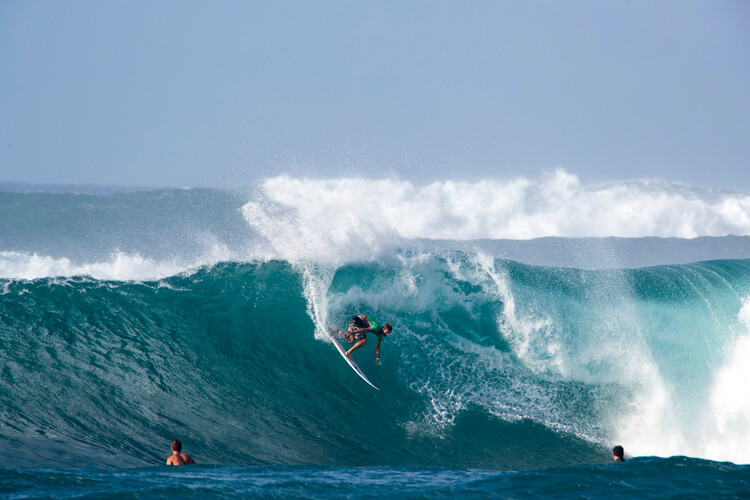
Finding an Opportunity
On the smaller days at Sunset, there are crowds of surfers, and there is a certain security in their numbers.
However, many of the muscular young men who prance into the water flexing their deltoids are never seen on the waves - they sit on their boards reflecting on their own particular brand of wisdom at not riding the monsters.
While one can sympathize with them, it is an attitude hard to understand.
These gentlemen are known as stockers because they stock up the big wave surfing numbers.
You also get the type who suddenly stiffens and says, "Oh, my back," as the waves get too high for comfort.
Less self-conscious people admit the waves are now too big for their particular surfing prowess.
Then they either go home, stay and watch, or start to take pictures. Like big game hunting, there is a satisfaction in the photography of a dangerous sport.
At Sunset, you have to be very fast to catch a big wave at all because of the off-shore winds.
The take-off must be gauged to a split second, and the drop must be carefully assessed to avoid the break, although it's almost as bad to be caught at the top as at the bottom on some waves.
You have to be in the mood to go out at Sunset, for even the best surfers have butterflies in their stomachs before a session, and after two or three days, get nervous and shaky with the tension and need a rest.
It's like a bombing raid or an eight-oared rowing race, ghastly before but wonderfully exhilarating afterward with that they-can't-get-me-roll-on-the-next-time feeling of superiority.
After I left the Islands in December, Larry and Bob Hansen started surfing Makaha and Sunset on milder days.
Although they were by this time competent surfers, neither of them was yet ready for big waves, but like myself and thousands of others, they both had aspirations.
They were also trying several other spots on the Islands, not known as surfing beaches.
They were passing Kohoku Point one day when they saw an incredible sight.
About a mile from Kewalo Bay, which is about five or six miles east of Sunset Beach, they noticed some large, clear, blue waves, with no surf, rolling endlessly toward the shore.
These waves were about 15 to 20 feet high and were between 600 yards and a mile out to sea.
After watching fascinated for about half an hour, the boys decided to go out and look at them without any intention of surfing.
As they approached from the left side, they could see the waves rolling forward in huge, beautiful undulations of transparent blue water, like whales schooling.
In front of each crest was a gradually sloping trough about 200 feet long.
They looked so inviting Larry and Bob were soon in their center, riding up and down like a carousel as each monster approached and passed at intervals of about 15 seconds and very gradually broke over about 300 yards closer to the shore.
The white water simply appeared at the top of the wave and slowly increased in bulk and power.
It was amazing how long the waves were holding up. They were not crashing over at all.
Occasionally Larry and Bob, in turn, would try to catch them so they could say they had surfed 20-foot waves, but they couldn't even get up enough speed to do this on the shoulders; each time, they would slide out into the calm sea.
Then they went back to being rocked by the huge swells, floating up and down like corks.
After half an hour, they felt very safe and secure because the waves continued, and it appeared they would do so indefinitely.
One of the disadvantages of any waves over four feet is that you cannot see what's behind them.
From the shore, if you are high enough, you can see everything, where they start, where they're breaking, and so on, but when you are out there sandwiched between the waves, you have a sort of fish's eye view of the universe, and it makes you a pretty small and' ineffectual object.
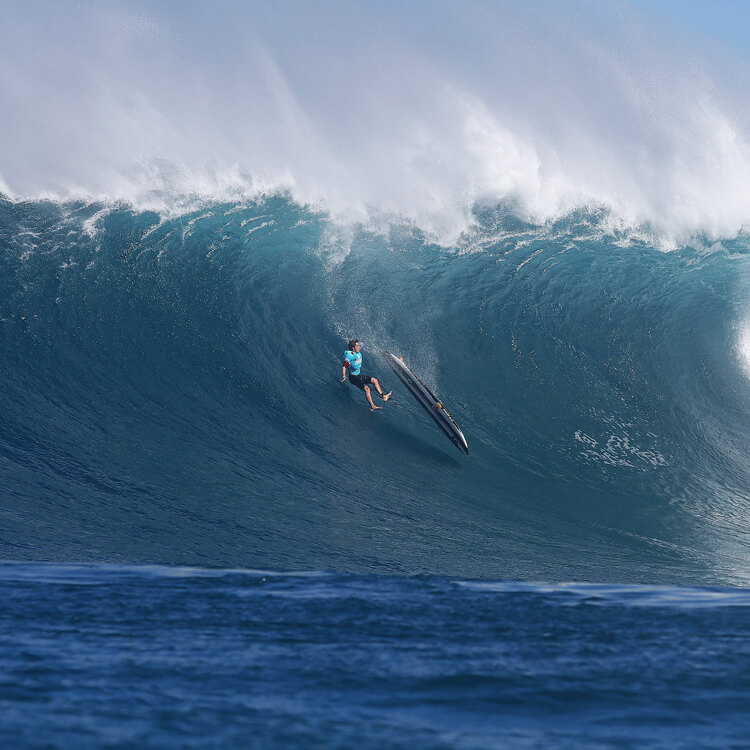
Wipeouts in High Surf
There is usually a feeling of insecurity of not knowing what's behind you when you are down at the bottom of the trough, which keeps you on your mettle.
But the boys had been rocked out of a state of awareness by the steady rhythm of the sea.
They had, however, taken the precaution of sitting themselves a wide distance apart with Larry on one side of the center and Bob on the other.
Suddenly as Larry rode smoothly up over a crest, to his complete horror, he saw that the next wave but one was about 30 feet high and was building up into a breaker.
For a second, he felt perfectly safe, as he was near the edge of the wave and thought he could prone out on the shoulder, but at the last moment, the whole wave changed direction.
It's a terrible thing to see these huge waves maneuver.
Larry let out a blood-curdling yell. He could now see two close-out waves, several hundred yards across, coming straight at him.
Bob, who, because of the change in direction had found himself on the edge, screamed, "Paddle for your life, Larry," and saw Larry going hell for leather for outside.
The first wave was by now almost vertical, and Larry, looking like a bug on a windowpane from Bob's position, struggled to within 2 feet of the top and hung there for a dreadful second before he and his board turned over and fell the full 30 feet plus, into the trough, as the whole lot came down on him like a concrete building collapsing.
Hundreds of tons of white water pounded him mercilessly into the sea, and he was certain that he was headed for oblivion.
Meanwhile, Bob had dived from his board to avoid some 20 feet thick soup, which had suddenly veered toward him.
Way down in the sea, he could feel the remnants of both of the giant waves clawing and grabbing at him.
Eventually, he came to the surface in a very weakened state and started to swim the half-mile to the shore.
They had both had the worst experience a surfer can expect, to be cornered in a situation that was not even vaguely anticipated.
Somebody who has not been trapped by the surf can have no idea of the sinking sense of hopelessness and dread that accompanies a moment like this.
You look wildly around for an avenue of escape, but you're alone with the enormous power of the giant waves, and you know your only chance is for a helicopter to drop out of the sky in the next ten seconds.
And then you vacate the scene in a great curved avalanche of white water like a dinghy being run over by an ocean liner.
As Bob neared the shore, he looked around and could see Larry still afloat but swimming very feebly.
He had taken a terrific pounding from the crushing power of the soup which had bounced him around mercilessly, down, down, down, round and round, over and over.
It was a nightmare - surely nothing could be this bad.
Never a strong swimmer, he had taken a draught of salt water which further weakened him.
Then he had a sudden terror of sharks and could barely swim thinking about them.
Larry discovered he had been stranded in the line up of a whole close-out set, and three big waves broke on top of him while he tried to swim down far enough to get out of their way.
Then the lull arrived, and for 15 minutes, he swam against the current making little headway, but enough to get out of the line-up.
Realizing that the worst thing to do would be to panic, he started to sing.
This helped him keep his mind off the sharks and off the current, which was continually bothering him, as almost without hope, he struggled to make headway.
With an enormous sigh of relief, Bob neared shore and prepared to retrieve his board in an attempt to go to Larry's aid.
But in one of those fortunate strokes of fate, two Hawaiian boys from Waikiki had been surfing inside the bay and had noticed the boards as they were swept in toward the beach.
They had immediately set off on their own boards to rescue him.
Larry was hardly moved from the position of the wipeout and was swimming very feebly.
When they got to him, cramps were developing in his legs and arms, and he was ready to sink, he said afterward.
"You crazy, man?" asked the leading Hawaiian in a burst of understatement.
They heaved him across the larger board, a sorry, limp figure, and paddled back to the beach for the inevitable post-mortem of the event (luckily not of Larry), which is still going on.
"I am not an expert swimmer and had no business out there in those big waves," said Larry, after he had recovered from the ordeal.
Fortunately, like most surfers, the Segedins are made of pretty stern stuff, and a couple of hours later, Larry was out surfing again.
Words by Desmond Muirhead | Golf Course Designer and Author of the Book "Surfing in Hawaii" (1962)
Chapter XI of "Surfing in Hawaii" was published under the authorization of Rosemary J. Muirhead, one of the three daughters of Desmond Muirhead
